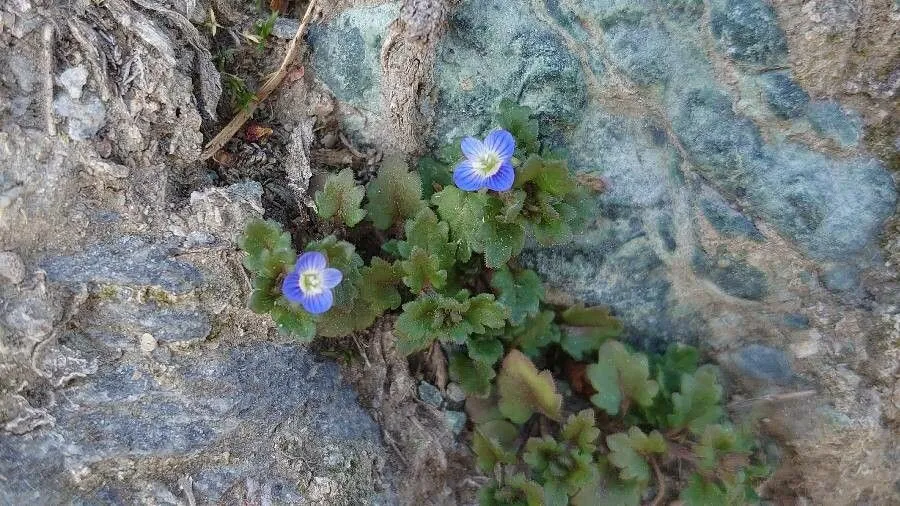
Author: Fr.
Bibliography: Novit. Fl. Svec.: 63 (1819)
Year: 1819
Status: accepted
Rank: species
Genus: Veronica
Vegetable: False
Observations: Europe to C. Asia and W. Himalaya, Canary Is. to N. Somalia
The Grey Field Speedwell, scientifically known as Veronica polita, is a captivating species belonging to the Plantaginaceae family. First documented in the early 19th century, this plant was detailed in the publication “Novit. Fl. Svec.” in the year 1819 by the author Fr.
Veronica polita holds a noteworthy presence across various geographical regions. It is native to a broad range stretching from Europe to Central Asia and extending to the Western Himalayas. Moreover, its distribution is not confined to these vast areas alone; the Grey Field Speedwell also thrives from the Canary Islands all the way to Northern Somalia.
This hardy plant has adapted to a variety of environmental conditions, showcasing its resilience and versatility. Often found in fields and meadows, the Grey Field Speedwell contributes to the biodiversity of the ecosystems it inhabits. Its delicate blue flowers and verdant leaves add a touch of elegance to the natural landscapes, not just in Europe and Asia, but also in parts of Africa.
Veronica polita is more than just a wildflower decorating the countryside. It plays a role in the local ecosystems, providing nectar for pollinators and contributing to the overall health of the habitats it occupies. Its widespread occurrence and ability to flourish in diverse climates underscore its importance as a species that enhances our natural world.
Dan: blank ærenpris
Deu: glaenzender ehrenpreis, glänzender ehrenpreis
Eng: gray field speedwell, grey field-speedwell, grey field speedwell, grey speedwell, wayside speedwell, gray speedwell
Nno: blankveronika
Nob: blankveronika
Nld: gladde ereprijs
Swe: glansveronika, kiiltotädyke, glansärenpris
Fin: kiiltotädyke
Ces: rozrazil lesklý, veronika lesklá
Fra: véronique à feuilles luisantes, véronique luisante
Cym: rhwyddlwyn llwyd, rhwyddlwyn-y-maes llwyd
En: Grey field speedwell, Wayside speedwell, Gray field speedwell, Grey Field-speedwell, Grey speedwell, Gray speedwell
Ar: حبق (حَبَق)، عشب المويه (عَشْب المويه), عكاش (عَكاش)
Ca: Verònica polida
Zh: Po po na
Cs: Rozrazil lesklý, Veronika lesklá
Da: Blank ærenpris
Nl: Gladde ereprijs
Fi: Kiiltotädyke
Fr: Véronique à feuilles luisantes, Véronique luisante, Véronique brillante, Véronique polie
De: Glaenzender Ehrenpreis, Glänzender Ehrenpreis, Glanz-Ehrenpreis
It: Veronica lucida
Nb: Blankveronika
Nn: Blankveronika
Es: Veronica polita
Sv: Glansveronika, Kiiltotädyke, Glansärenpris
Cy: Rhwyddlwyn Llwyd, Rhwyddlwyn-y-Maes Llwyd
© copyright of the Board of Trustees of the Royal Botanic Gardens, Kew.
© copyright of the Board of Trustees of the Royal Botanic Gardens, Kew.
© copyright of the Board of Trustees of the Royal Botanic Gardens, Kew.
Taken Mar 8, 2020 by Jiří Vilím (cc-by-sa)
Taken Aug 24, 2014 by Tela Botanica − Marie PORTAS (cc-by-sa)
Taken Mar 19, 2022 by Sylvain Piry (cc-by-sa)
Taken Mar 10, 2018 by Llandrich anna (cc-by-sa)
Taken Mar 10, 2018 by Llandrich anna (cc-by-sa)
Taken Mar 25, 2021 by hernandez astrid (cc-by-sa)
Taken Jan 9, 2022 by Lupe Aguilar (cc-by-sa)
Taken Mar 10, 2018 by Llandrich anna (cc-by-sa)
Taken Feb 20, 2022 by Manū (cc-by-sa)
Taken Feb 20, 2022 by Manū (cc-by-sa)
Taken Jul 19, 2021 by David Hocken (cc-by-sa)
Taken Feb 11, 2022 by Miguel A. C. (cc-by-sa)
Taken Jan 16, 2022 by Miguel A. C. (cc-by-sa)
Taken Mar 10, 2018 by Llandrich anna (cc-by-sa)
Taken Feb 20, 2022 by Manū (cc-by-sa)
Taken Feb 11, 2022 by Miguel A. C. (cc-by-sa)
Taken Feb 27, 2020 by Estevenon Guilhem (cc-by-sa)
Taken Feb 27, 2020 by Estevenon Guilhem (cc-by-sa)
Taken Jan 16, 2022 by Miguel A. C. (cc-by-sa)
Taken Feb 20, 2022 by Manū (cc-by-sa)
Taken Apr 16, 2021 by Tyhjä Luut (cc-by-sa)
Taken Aug 22, 2021 by Pierre LEON (cc-by-sa)
Taken May 27, 2011 by Tela Botanica − Bertrand BUI (cc-by-sa)
Taken Feb 25, 2017 by Francesc Riudavets (cc-by-sa)
Taken Mar 3, 2020 by Llandrich anna (cc-by-sa)
Taken Feb 26, 2015 by Tela Botanica − Liliane Roubaudi (cc-by-sa)
Taken Feb 26, 2015 by Tela Botanica − Liliane Roubaudi (cc-by-sa)
Taken Jul 10, 2010 by Tela Botanica − Yoan MARTIN (cc-by-sa)
Taken Feb 26, 2015 by Tela Botanica − Liliane Roubaudi (cc-by-sa)
Taken Feb 26, 2015 by Tela Botanica − Liliane Roubaudi (cc-by-sa)
Growth habit: Forb/herb
Ph maximum: 8.0
Ph minimum: 7.5
Light: 7
Atmospheric humidity: 5
Bloom months: [‘mar’, ‘apr’, ‘may’, ‘jun’, ‘jul’, ‘aug’, ‘sep’, ‘oct’]
Soil nutriments: 7
Family: Myrtaceae Author: (F.Muell.) K.D.Hill & L.A.S.Johnson Bibliography: Telopea 6: 402 (1995) Year: 1995 Status:…
Family: Rubiaceae Author: Pierre ex A.Froehner Bibliography: Notizbl. Bot. Gart. Berlin-Dahlem 1: 237 (1897) Year:…
Family: Sapindaceae Author: Koidz. Bibliography: J. Coll. Sci. Imp. Univ. Tokyo 32(1): 38 (1911) Year:…
Family: Asteraceae Author: A.Gray Bibliography: Pacif. Railr. Rep.: 107 (1857) Year: 1857 Status: accepted Rank:…
Family: Fabaceae Author: Medik. Bibliography: Vorles. Churpfälz. Phys.-Ökon. Ges. 2: 398 (1787) Year: 1787 Status:…
Family: Aspleniaceae Author: (Cav.) Alston Bibliography: Bull. Misc. Inform. Kew 1932: 309 (1932) Year: 1932…